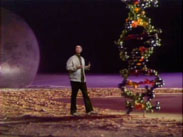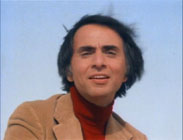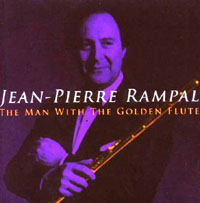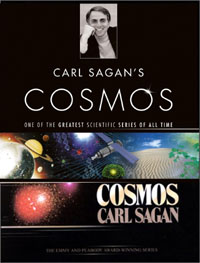|
The episode begins with two "grabbers", to put viewers in their seats
and generate interest in today's topic. First is a short poetic tour
of space in the ship of the imagination, showcasing the then-groundbreaking
special effects (quite cool, but a bit of a re-run), while the narration this time
emphasizes how a search for life in space requires
us to be on top of all of the scientific requirements for life.
The second grabber is more memorable, but not something many of us will want
to re-watch too many times. A morbid tale of ancient Japanese politics
leads into the concept of artificial selection, and how a species of tiny crabs
came to have something resembling the face of a Samurai warrior on their backs.
I'll be skipping the morbid politics section of this most times I re-watch this episode.
Central Excellence
After this, the bulk of the episode focuses primarily on evolution, and the
backbone of chemistry at its heart. It's particularly good at taking us through
the entire timeline of evolution, plotted out on the Cosmic Calendar introduced
in the previous episode. Firstly we get fascinating detail of the formation of the Earth
and its early chemical make-up, with some nicely atmospheric audio/visuals.
Then we go through all the various forms that led from the earliest examples of life
all the way to Human beings, noting along the way some of the alternate branches
that led to plants, reptiles, birds, insects, etc. Some of the visuals here may seem
fairly basic, but they get the job done, and it is good that the episode attempts to
go through all the details of the complete chain as known by science at that time.
Other excellent highlights include an exploration of the grounds and central "hothouse"
of the Kew Botanical Gardens in England, to highlight the variety of life on Earth,
and the similarities still shared by all life forms we currently know.
We also get to experience a fascinating journey into the world of a blood cell,
all the way down to a DNA molecule in the process of replicating itself. The visual
effects techniques here used every known trick in the book at that time,
up to and including early computer generated imagery, and is therefore fascinating both
for the content being delivered and for making a bit of history with the style
and method of delivery. Super stuff.
Niggling Caveat
If there's any one thing that bothers me during this mostly excellent center to the episode,
it is the occasional mentions by Sagan that evolutionary variations arise
"randomly", "quite by accident", "purely by chance"... especially when he expects
his audience to swoon over that explanation as he is doing himself. Has science
proven that these things are random, or has it merely assumed them to be so in the absence
of any other mechanism having met their publicly acknowledged approval yet,
at the time this was made?
What I really want to draw attention to here, is the tendency all of us seem
to share when making a new discovery. Often, when we figure out one piece
of any particular puzzle of nature, we tend to jump to the conclusion that
we've solved the entire puzzle. Yes, Sagan's got his finger on a fascinating
piece in this episode, but it does bother me when he portrays it as the
whole deal and gets all excited about this being "it".
Let me draw for you an expanded picture of evolution. Firstly, there are
two phases to the process - the origin of variations, and the filters
through which variations must pass to get from one generation to the next.
In this episode, Sagan promotes the concept of the natural selection filter,
while also using the tale of the Japanese crabs to demonstrate a not-so-natural
version he labels "artificial selection". I'm not so sure the difference
between the two is really worth anything, as it would imply that there
is something somehow unnatural about Humans and Human decision-making.
Folding our own species back into our concept of nature is, I think,
one of the challenges we face if we are to evolve into
Fourth Density. But for all his examination
of the DNA molecule and its component parts, natural and artificial selection
are about the only parts of the mechanisms of evolutionary change
that he really covers or acknowledges here.
These are great for minor variations of appearance or function WITHIN
any one species.
The Need for Kickstarter Genepools
However, studies of evolution often butt up against another filter, which has
baffled scientists and caused much debate. If the defining attribute of
a species is the ability of its members to procreate with each other,
and only when the DNA of two organisms is incompatible can we say that
they are of truly different species, a new species cannot arise slowly.
One new member of a new species, created randomly all on his lonesome,
will have no one he can procreate with. He will die out, without
passing anything to a new generation, and this species won't ever get started.
An entire kickstarter gene pool has to appear within one generation,
such that the new species can procreate and continue.
How big a gene pool
would a new species need to get a healthy foothold and continue on and on?
If there were only one Adam and one Eve, the next generation would require
brothers and sisters to mate with each other. Incest generally isn't too
healthy, genetically speaking. The film
The Matrix: Reloaded seemed to suggest that
seven males and sixteen females constituted a good kickstarter genepool
for the rebirth of Zion, but whether this works as a bare minimum
might yet be questionable.
Just how likely is it that an entire kickstarter genepool can appear
in one generation, to allow a whole new species to branch out of another,
get a solid foothold, and continue on down through time? To answer that
we have to look at the complementary phase of evolution, the mechanisms
that create the variations in the first place.
And this is where Cosmos is disappointing and unfulfilling. Sagan only
looks at the simplest and least powerful mechanism of all - radiation
making a random "copying mistake" on a DNA molecule. Adding to the incredulity
of the odds that need to be overcome, remember that every cell in an organism
has its own DNA in the nucleus. If one of my cells gets hit and mutates
and changes, the rest of my cells carry on as normal. Radiation would have
to hit a sperm or egg cell prior to procreation, or a newly formed being
before its very first cell division - when it is only one cell in size -
to have any lasting impact. And incidentally, much as I think the morphing
cartoon outlines showing one species evolving into another in this episode are cool,
perhaps this visual encourages us to forget that one whole plant or animal
doesn't morph into something new when zapped by radiation. If he's zapped,
and it's not fatal, it's his children that might look different.
This single mechanism for the creation of variation seems woefully
inadequate, all things considered, and philosophically speaking,
it is very much the product of the billiard ball winding-down-clockwork
physics that dominated western science for several centuries. Pardon me
if I'm not quite as thrilled by it as Sagan and his colleagues,
particularly in light of the fact that the existence of other mechanisms
for creation of variation is now scientifically rock-solid.
| Pieces of the Evolution Puzzle |
| Origin of VARIATIONS |
Filters |
- Random Radiation Mutation
- Stress rewriting genes
- deliberate genetic modifications
- ?????
|
- Natural Selection
- Artificial Selection
- Interspecies Gene-pool Barrier
|
(Anything written in green text
represents something
Cosmos largely left out which I believe is vitally important.)
Additional Mechanisms
We can increase the number of mechanisms for creation of variations...
personally I tend to think of at least four of them. Of them,
radiation mutation is the most random and displays the least intelligence.
As we work through the others, each of them in turn will be less random
and display a greater application of intelligence. In other words,
less chaos, and more cosmos.
The second of these is a fairly recent discovery, heavily promoted by
Dr. Bruce Lipton, who has done
extensive laboratory research into cell biology and behaviours. Apparently,
most cells have genes whose sole function is to re-write the other genes.
This rewriting process is activated by environmental stresses, and only
after several other biological mechanisms for dealing with stress have
been found to be insufficient in overcoming the challenge. Now, it
still seems to be a bit of a crap-shoot as to what you get from a gene
rewriting another gene - the likelihood is still that you'll get something
either useless or even harmful. But the fact that this mechanism even exists
goes a long way to increasing the likelihood that, when a species is
suddenly really under the gun for survival, vast numbers of variations
will be produced quickly, increasing the likelihood of creating a kickstarter
genepool for a new species. And because an individual of that new species
got there via a gene-rewriting-gene process, the odds are astronomically improved
that the exact same variation was made to other individuals within the same
stressful environment. In other words, if you adapt into a new species
via this method, chances are you're not alone, and you might have fellow
adapters in this new species with whom you can have offspring.
Option three seems to be undeniable these days, and indeed gets a brief
tossed off mention in Cosmos episode two as "disquieting and awesome"
before being forgotten. Human beings are intelligent and manipulative enough
that the power to deliberately sequence genes however we might want, in as large
a kickstarter genepool as we would want, gives us a method of creating new
species that actually looks to be the most rock-solid of all scientifically.
It overcomes all the technical problems of evolution, and only leaves us with
ethical questions to consider. But if evolution is to have this largely non-random
mechanism at its disposal from now on, do we really want to latch onto theories
that don't allow for this mechanism to be at play in our past? Though it
may uncomfortably complicate things for many scientists, I think this mechanism
needs to be considered in our look at our past. Ancient aliens, and their
possible genetic experiments, cannot be adequately disproven without
adequate open study.
|
Interestingly, Astrophysics professor Adam Frank of the University of Rochester has
just recently co-authored a new paper which takes recent statistics concerning all that
we've now learned from our discoveries of thousands of exoplanets orbiting other stars,
and plugs all that into the infamous Drake Equation, which "Cosmos" will cover
in episode 12. His findings suggest that even the most conservative estimates
for the remaining unknowns in the equations still insist that vast numbers of
technologically advanced civilizations must have existed at some point. How many
of them discovered deliberate genetic manipulation? Can we be sure they didn't
use any of that knowledge to affect the Earth at any point in our history?
|
|
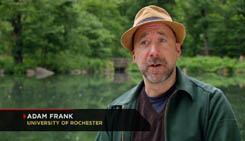
Adam Frank in "The Universe"
episode 63: Total Eclipse
|
And finally, there may be yet a fourth mechanism for variation,
the one displaying the highest level of intelligence and the least amount
of randomness. Is the entire universe alive with consciousness?
Does that consciousness affect the very assembly of molecules?
To what degree do emotions indicate the quality of our thoughts,
and the quality of molecular and chemical interactions?
Will a mind under stress rewrite a gene in ways to express that stress,
whereas a mind emotionally focused on a solution will rewrite a gene to express
a glorious new variation with improved ability? Have perhaps
various species, even life itself, come about because the universe at large,
in some way fundamental to the very vibrations of subatomic strings,
willed them into being? This is perhaps still a question dominated by
the various disciplines of spirituality more than those of science,
but how many scientists really want to rule such things out?
This second episode of Cosmos recreates the Miller-Urey experiment,
where the raw chemistry of life, receiving sufficient electrical charge,
comes together to form proteins and amino acids - the basics required
for the alphabet of DNA. It is left open to interpretation, and may
be for much time to come, to what degree this process is just random,
or whether such circumstances are windows through which life is keen
to will itself into ever more tangible and complex forms of expression.
Finally this episode speculates on the very different kinds of life
that might inhabit the atmosphere of a gas giant planet such as Jupiter,
an awesome segment that helps stretch the imagination and test the limits
of our sense of accepting new ideas into science. Two thumbs way up!
Then we get our first Cosmos Update section from 1990,
which focuses on a few odd molecular details and
isn't all that interesting quite frankly. Meh.
This is an episode that has ups and downs of varying quality,
and covers its subject matter in ways that are a bit glaringly lacking today.
Though it remains a good primer for many aspects of biological chemistry
and evolution, it remains a bit dangerous in painting its great pieces of the
puzzle as the whole picture, and may leave its audience a bit too content
in not searching for the unmentioned remainders....
|
